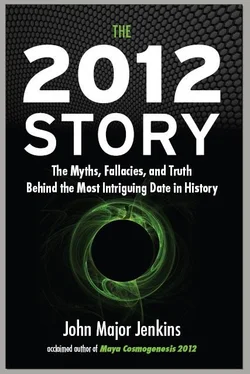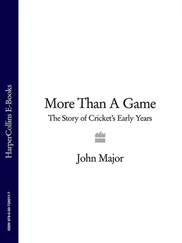Chapter 1 presents the indispensable discoveries and academic work that over many centuries have led to an astonishing picture of ancient Maya civilization. How did explorers come to rediscover the lost cities of the Maya? How did scholars come to reconstruct the calendar systems? How did breakthroughs and biases help and hinder the process? And going further back in time, how and when did civilization in Mesoamerica develop? The material covered in Chapter 1 could easily have been expanded into a book of its own, telling the story of fascinating rogues and colorful characters who discovered and explored the jungle temples of ancient Maya civilization, reconstructing an entire worldview beginning with the barest of fragments. Since my goal was to write one book rather than a ten-volume series, I have summarized the most notable events and as a result many interesting episodes and characters have been left out.
Distilling the endless information down to its alchemical essence, I’ve highlighted certain themes that I believe define the remarkable ongoing process of recovering the lost knowledge of the Maya, America’s most persistently mind-boggling civilization. One of these themes is the important place occupied, time and again, by the independent outsider. Quirky, eccentric, dealing genuine insights and controversial fancies, they have been the triggers and the mainstay of real progress. Visionary philosopher Terence McKenna said in one of his talks:
What we need to celebrate is the individual. Have you not noticed (I certainly have), that every historical change you can think of—in fact any change you can think of, forget about human beings—any change in any system that you can think of is always ultimately traceable to one unit in the system undergoing a phase state change of some sort. There are no group decisions, those things come later. The genius of creativity and of initiation of activity always lies with the individual. 2
The efforts made by these upstarts to transcend status quo biases inflicted by degreed gatekeepers wielding their own limiting brands of logic and decorum can be observed time and time again. Usually the truth eventually came through, even though it was often reviled and marginalized for decades and the trailblazers themselves died without due acknowledgment.
I count myself among the autodidacts, the self-taught perpetual students fueled by passion and a sense of mission. The early independent Maya researchers had little to work with. Things have sped up since the days of Förstemann, Goodman, and Bourbourg, and I expect the next decade will see many unexpected breakthroughs in how we understand Maya astronomy, the hieroglyphic inscriptions, and the much maligned and misunderstood 2012 date—including, as we will see, new evidence that supports my reconstruction of the original intentions behind the 2012 date. Even after the 2012 party is over, the work will continue.
Another theme is 2012’s wide appeal. By this I mean it is of interest to scientists, New Age spiritualists, novelists, survivalists, evangelizing model makers, and the mass media—although, it must be said, its millenarian aspect finds particularly fertile soil in the United States. Whether manifesting in negative or positive aspects, 2012 nevertheless has meaning in virtually every domain where it appears. This situation calls into question critics who declare, with a surprisingly smug certainty, that 2012 is a hoax or completely meaningless. I’ve observed and directly experienced this treatment and have dialogued with those who inflict it, so I feel obligated to report the following: In academia as well as in the skeptical popular press, 2012 is rendered meaningless to the extent that it is misunderstood. This is an interesting equation. If a prejudice exists that 2012 is meaningless, then myriad creative ways to misunderstand it can and must be implemented. One overarching misunderstanding is endlessly repeated: that the Maya predicted the end of the world in 2012. 3If you look at the Maya doctrine of World Ages, the hieroglyphic inscriptions that relate to 2012, and the Creation Mythology ( The Popol Vuh ), you find nothing of the sort. These misconceptions have currency because access to good information on 2012 has been either seriously limited or buried under the endless bric-a-brac of the spiritual marketplace. Discerning books and websites, including my own, are out there and have been for years, but they must compete with formulaic attention-grabbing marketplace products that are almost always sensationalized and riddled with errors.
I found it challenging to review, for this book, the many distortions and misapprehensions that have clogged the 2012 marketplace. I felt it would be important to clarify, for the record, the facts of the matter and have assessed materials from theories, models, so-called prophets, and visionaries. The real stories that underlie many of these authors and ideas are filled with ironies, debacles, and exposés, and I happen to have had the insider’s view of all these telltale goings-on in the tortured topic of 2012. I offer my carefully considered overviews and assessments on the best-known theories connected to 2012, and I provide these candid critiques as a guide for unwary wayfarers on the road to 2012. Much of what is connected to 2012 is misleading and panders to fear and paranoia. Delving into this messy situation will, I hope, be made easier with some well-placed sardonic humor and wry wit. One thing I’ve learned from twenty years in the 2012 game is that humor is absolutely necessary if one hopes to survive the 2012 superstorm of surreal scenarios that are flooding the discussion. Surprisingly, we’ll find that an unwillingness to investigate the 2012 topic rationally , which is diagnostic of many misconceptions in the popular literature, also infects academia. A critical survey of the “modern Maya calendar movement” and its relationship to academic treatments will be a frequent reference point.
Part I was conceived as a nuts-and-bolts chronological survey of the 2012 topic, bringing us up to speed on the facts of the matter. Summarizing the various theories inevitably invites a presentation of my reconstruction work and “galactic alignment theory.” Chapter 4 frames this presentation within the larger issue of how breakthroughs occur, emphasizing that my work is built upon the previous breakthroughs of other scholars working in Maya studies. With new decipherments of hieroglyphic texts, the multifarious ways in which the ancient Maya utilized the concept of the alignment of the solstice sun and the Milky Way’s dark rift (the “galactic alignment”) in their traditions is becoming clearer. I found that the Maya ballgame, king-making rites, and the Maya Creation Mythology encoded the astronomy of the era-2012 alignment, which happens only once every 26,000 years. This galactic alignment is caused by a phenomenon called the precession of the equinoxes, the slow shifting of the positions of the equinoxes (and solstices) in the sky, resulting from the fact that the earth wobbles very slowly on its axis. My end-date alignment theory is now receiving new support from recent findings in academia, and after 2012 I’ll continue the work that I’ve pursued since the mid-1980s.
This astronomical alignment has been generally and more compellingly referred to as an alignment to “the Galactic Center,” a cause for confusion in terms of timing parameters, which I will explain and clarify. When the dust settles, I am confident that a paradigm justly identified as “galactic” in scope will become the consensus in academia and that college textbooks will include tutorials in hieroglyphic statements involving the dark rift in the Milky Way, precessional concepts and calculations in hieroglyphic inscriptions, and readings of the astrotheological iconography of pre-Classic Izapa.
Читать дальше












